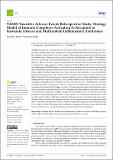| dc.contributor.author | Ricke, Darrell O. | |
| dc.contributor.author | Smith, Nora | |
| dc.date.accessioned | 2024-03-27T15:38:49Z | |
| dc.date.available | 2024-03-27T15:38:49Z | |
| dc.date.issued | 2024-03-07 | |
| dc.identifier.issn | 2075-1729 | |
| dc.identifier.uri | https://hdl.handle.net/1721.1/153949 | |
| dc.description.abstract | Background: Vasculitis diseases include Kawasaki disease (KD), Kawasaki disease shock syndrome (KDSS), Multisystem Inflammatory Syndrome (MIS), Henoch–Schönlein purpura (HS), or IgA vasculitis, and additional vasculitis diseases. These diseases are often preceded by infections or immunizations. Disease incidence rates are higher in children than in adults. These diseases have been extensively studied, but understanding of the disease etiology remains to be established. Objective: Many studies have failed to demonstrate an association between vasculitis diseases and vaccination; this study examines possible associations. Methods: Herein, the Vaccine Adverse Event Reporting System (VAERS) database is retrospectively examined for associations between vasculitis diseases and immunizations. Results: For some vaccines, the number of rare cases of KD, MIS, and HS are higher than the background rates. These rare cases are predicted to occur in individuals with (1) genetic risk factors with (2) antibody titer levels above the primary immune response level. Herein, the model of humoral immune response antibodies bound to antigens (pathogen or vaccine) creating immune complexes is proposed. These immune complexes are proposed to bind Fc receptors on immune cells and platelets, resulting in cell activation and the release of inflammatory molecules including histamine and serotonin. Immune complexes and inflammatory molecules including serotonin and histamine likely trigger vasculitis. Elevated serotonin and possibly histamine drive initial vasoconstrictions, disrupting blood flow. Increased blood flow pressure from cardiac capillary vasoconstrictions is predicted to trigger coronary artery aneurysms (CAA) or lesions (CAL) in some patients. For KDSS and MIS patients, these cardiac capillary vasoconstrictions are predicted to result in ischemia followed by ventricular dysfunction. Ongoing ischemia can result in long-term cardiac damage. Cases associated with pathogens are likely to have persistent infections triggering disease onset. Conclusion: The proposed model of immune complexes driving disease initial disease etiology by Fc receptor activation of immune cells and platelets, resulting in elevated histamine and serotonin levels, is testable and is consistent with disease symptoms and current treatments. | en_US |
| dc.publisher | MDPI AG | en_US |
| dc.relation.isversionof | 10.3390/life14030353 | en_US |
| dc.rights | Creative Commons Attribution | en_US |
| dc.rights.uri | https://creativecommons.org/licenses/by/4.0/ | en_US |
| dc.source | Multidisciplinary Digital Publishing Institute | en_US |
| dc.subject | Paleontology | en_US |
| dc.subject | Space and Planetary Science | en_US |
| dc.subject | General Biochemistry, Genetics and Molecular Biology | en_US |
| dc.subject | Ecology, Evolution, Behavior and Systematics | en_US |
| dc.title | VAERS Vasculitis Adverse Events Retrospective Study: Etiology Model of Immune Complexes Activating Fc Receptors in Kawasaki Disease and Multisystem Inflammatory Syndromes | en_US |
| dc.type | Article | en_US |
| dc.identifier.citation | Life 14 (3): 353 (2024) | en_US |
| dc.contributor.department | Lincoln Laboratory | |
| dc.identifier.mitlicense | PUBLISHER_CC | |
| dc.eprint.version | Final published version | en_US |
| dc.type.uri | http://purl.org/eprint/type/JournalArticle | en_US |
| eprint.status | http://purl.org/eprint/status/PeerReviewed | en_US |
| dc.date.updated | 2024-03-27T13:15:39Z | |
| dspace.date.submission | 2024-03-27T13:15:39Z | |
| mit.journal.volume | 14 | en_US |
| mit.journal.issue | 3 | en_US |
| mit.license | PUBLISHER_CC | |
| mit.metadata.status | Authority Work and Publication Information Needed | en_US |
